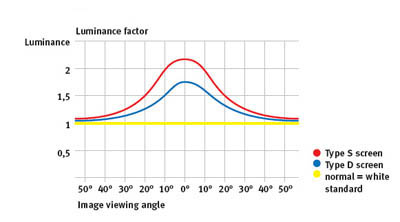|
An audience typically retains about 20% of a simple verbal presentation.
If a speech is complemented with visual information, e.g. with images projected
onto a screen, an audience will retain at least 60–80% of the information simultaneously heard and seen.
However, effectiveness of any presentation depends on the audience being able to view the information clearly and legibly. A good quality projection screen always plays the important role in the success of any presentation and increases the amount of information an audience retains. It also goes without saying that the quality of the demonstrated movies much more
depends on the quality of your projection screen`s surface.
In order to make the right choice of a projection screen you should
determine:
1) Type of screen – Mobile or Fixed;
2) Screen size and aspect ratio (width/height) of the projected image;
3) Type of screen fabric (cloth);
4) Type of projection equipment
1. Type of screen - Mobile or Fixed (Wall or Ceiling
Mounted).
Firm Alpha offers quite the large range of both types projection screens
manufactured by Medium GmbH (Germany).
Before a purchase of a screen, you should determine whether your screen
will be permanently installed in a hall (Wall/Ceiling Mounted) or it will be
used in different places (Mobile Screen).
At your choice are both manually and electrically operated Medium screens for
wall/ceiling installation. If flexibility is paramount, you can choose from a
wide selection of tripod, foldable and portable mobile Medium projection
screens.
2. Screen size and aspect ratio
When considering the correct screen size the most important criteria are: room
dimensions, the seating arrangements, and the relevant projection technology.
The audience should not be seated too close to the screen as they will not be
able to view the whole image. Equally the audience should not be seated too far
away from the screen.
Determine the dimensions of the screen:
à)Width of the screen should be equal or less than 1/2 of the distance from the
screen to the first row of spectators; b)Width of the screen should be equal or
less than 1/6 of the distance from the screen to the last row of spectators.
If the estimated values differ, then for the width of the screen the biggest
value should be adopted.
Height of the screen is easily computed by means of simple arithmetical
calculations proceeded from the chosen projection format or aspect ratio
(correlation of the screen sides): 1:1 – overhead projection standard;
4:3 – video projection /modern TV standard/, or 16:9 - standard of
wide-screen cinemas and high definition television (HDTV). For PC presentation
is mostly used 4:3 aspect ratio, but nowadays 16:9 projection
format is also popular.
Determination of the screen height from the floor:
a)Height of the screen from the floor should be equal or more than 1/8 of the
distance from the screen to the last row of spectators;
b)In the rooms with horizontal floor the distance from the floor to the lower
edge of the screen should be not less than 1,3 – 1,5m. It is not advisable to
elevate the screen higher, as in that case the review will be very exhausting
for the audience.
3. Type of screen surface (fabric)
The reflective properties of a front screen surface are also crucial for selection
of the correct projection screen and are defined as the luminance factor (also
called the gain factor). The gain factor measures the efficiency of a screen
surface in reflecting the light flow and indicates how much higher is the
proportion of the reflected by the particular screen light in comparison with a
standard white surface. There is also a direct correlation between the gain
factor and the viewing angle:
The higher the gain factor, the more restricted is the viewing angle. The
viewing field is twice the viewing angle. Different coatings of the screen
surface result in different reflective properties.
There are two different front screen surfaces: screens with a Type D surface
and screens with a Type S surface.

Type D front screen surfaces (d=diffuse)
This screen surface is particularly suitable for projection in more or less
darkened rooms. The audience can be seated over a wide area.
● scatter the light in all directions (horizontally and vertically)
● are matt white ● have a viewing angle of 45 to 50 degrees.
● have a gain factor of 1 -1.2
Type S front screen surfaces (s = specular)
This screen surface is suitable for use in environments with high ambient light.
The seating arrangement should be adjusted to accommodate the narrower viewing
cone.
● reflect the light along the projection axis twice as brightly as matt white
projection screens
● have a mother-of-pearl tint
● have a viewing angle of approximately 30 to 40 degrees
● have a gain factor of
2 -2.2
If you need a REAR projection screen please have a look at foldable Medium Exclusive and Standard screens with rear projection cloth. You may also order this high quality fabric with 0.8 transparency coefficient separately, without any frame.
4. Type of projection equipment
In addition to the previous criteria, the
choice of projection technology (digital, slide or overhead) also plays an
important role. All existing projection devices available should be taken into
account when deciding a screen purchase.
|